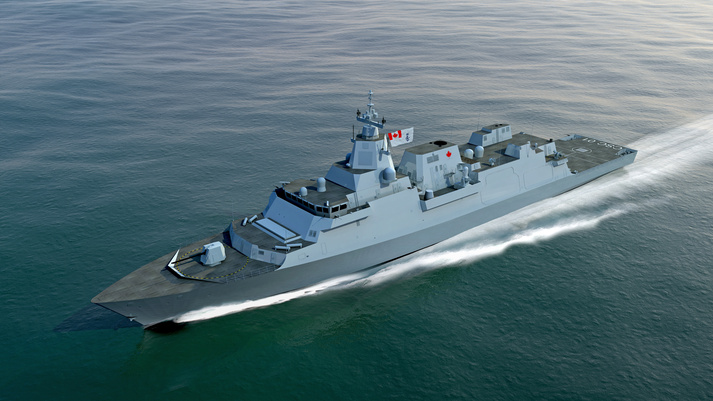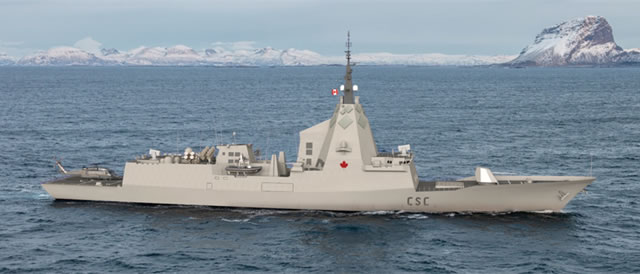The 3 consortiums that submitted bids for the CSC had their final Submissions due last Friday on the 20th. this final submission allowed them to clean up and clarify portions of the submissions based on feedback from the federal government and Irving.
The Three Bidders Are:
 Canada’s Combat Ship Team – composed of Lockheed Martin, BAE Systems and CAE, MDA, L3 Technologies, and Ultra Electronics – submitted their proposal based on the British Type 26 Global Combat Ship. the British are currently building this ship, though it is not yet in service.
Canada’s Combat Ship Team – composed of Lockheed Martin, BAE Systems and CAE, MDA, L3 Technologies, and Ultra Electronics – submitted their proposal based on the British Type 26 Global Combat Ship. the British are currently building this ship, though it is not yet in service.
Alion Science and Technology-led team with a proposal based on the De Zeven Provinciën Air Defence and Command frigate which is in service with the Dutch Navy. The combat system solution is based on the world-class capabilities of ATLAS-Elektronik and Hensoldt Sensors
 The third bidder is Spanish Navantia with its F-105 frigate design. The company will partner with Saab and CEA Technologies to deliver the ships should it be selected. The F-105 is a variation of the Spanish Álvaro de Bazán-class frigates and is the basis for the Norwegian Fridtjof Nansen class, and the under construction Australian Hobart Class. The ships use the American Ageis system. Their CSC Proposal is fitted with a 127mm main gun by Leonardo, a CEAFAR2 radar by CEA, 2x RAM launchers by Raytheon, 2x 35mm Millenium CIWS guns by Rheinmetall, 48x VLS and 8x RBS-15 Mk3 anti-ship missiles by Saab
The third bidder is Spanish Navantia with its F-105 frigate design. The company will partner with Saab and CEA Technologies to deliver the ships should it be selected. The F-105 is a variation of the Spanish Álvaro de Bazán-class frigates and is the basis for the Norwegian Fridtjof Nansen class, and the under construction Australian Hobart Class. The ships use the American Ageis system. Their CSC Proposal is fitted with a 127mm main gun by Leonardo, a CEAFAR2 radar by CEA, 2x RAM launchers by Raytheon, 2x 35mm Millenium CIWS guns by Rheinmetall, 48x VLS and 8x RBS-15 Mk3 anti-ship missiles by Saab


CSC Type 26: The “Best” Option:
All the bidding companies have multi-purpose frigates either in service, under construction or planned that can do the job, but there is just one design for Canada that will offer a balanced plug-and-play approach, and that design is, without question, in my opinion, the Lockheed-Martin (LM)/BAE consortium Type 26 anti-submarine warfare (ASW) frigate. The BAE Type 26 ASW frigate is a cutting-edge warship that is simply the best fit for Canada’s future workhorse navy. It is a modern warship with all the capabilities Canada requires in a CSC. The Type 26 is infinitely adaptable, can easily be reconfigured and the RCN can tweak the design to cater to its own development requirements, which is where the Type 26 has the potential to excel. The MK 41 Vertical Launch System (VLS) could be reconfigured from 24 to 48 or even 64 cells to accommodate a precision strike and BMD capability. Some have suggested that Canada cannot afford the Type 26 frigate at approximately $2.5/3 Billion CAD per ship in 2018 dollars. The $61 billion CAD allocated for the build will ensure the RCN gets the ‘best bang for the buck’ enabling a more robust AAW MK 41 VLS with a BMD capability along with an AEGIS-style platform. The first three or four Type 26 frigates could very easily have this extra capability incorporated into their design . A reconfigurable mission bay can accept containerized loads to allow the rapid reloading of the vessel. Such loads might include aid/rescue packages, underwater vehicles, boats or naval drones. This ship exceeds Canada’s high requirements, would be deployable worldwide for extended periods and would be more than capable of replacing both the RCN’s anti-air and anti-submarine capabilities with one single class of ship. The plan is for first steel to be cut in Canada by 2020/2021 for the prototype phase, designed to prove the processes and Irving Shipyard’s new production facilities in Halifax. Full production would commence in 2022 with the first ship due to be delivered around 2027. The schedule will mean that BAE’s Type 26 ships – HMS Glasgow, Cardiff and Belfast – will be in production ahead of the first Canadian ship, making the lead CSC Type 26 the “Canada Class”, with the Royal Navy taking the lead in understanding the design, developing its capabilities and addressing any snags.
Should the LM/BAE consortium Type 26 CSC be successful, there would be considerable benefits for the Canadian and British shipbuilding industry. On a strategic level, Britain and Canada have similar cultural and interests and both are part of the ‘Five-Eyes’ agreement for the sharing of classified intelligence. An exchange of highly sensitive ASW tactical information and experiences would flow naturally from joint CSC collaboration. The RCN has conducted personnel exchanges with the RN going back to the founding of the Canadian Navy and this mutually beneficial joint experience would only increase. Although the armament, sensors and combat system fitted to the CSC will differ in some respects, there would still be a significant commonality of components that will come from the UK, especially the propulsion system. Economies of scale across the supply chain will help reduce both construction and through-life costs for both countries. The Canadian government will fund the cost of refining the Type 26 into the detailed LM/BAE Type 26 proposal with more Canadian personnel being employed in the pre-project teams, in both Glasgow, Scotland, and Canada. There would be further work for these valuable specialists, with an emphasis on a transfer of engineering and project management skills to Canada. Success would vindicate the CSC design and should both Canada and Australia adopt the BAE Type 26 program, these three close allies would operate a total fleet of 32 sister ships.
If Canada is to gain the most value for money, in a project the effects of which are planned to span more than 40 years from construction to disposal, the Type 26 Global Combat Ship is the wisest and most common-sense decision. While embryonic in terms of shipbuilding (if selected, the RCN build timeline will commence three years after that of the UK’s Type 26 frigates), to deride the platform as an ‘unproven ship’ is to sell the project short. BAE is no slouch in ship design, and the UK has taken many steps to ensure a robustness and surety in the design of the platform and its systems before build, most notably by conducting trials of its technologies on existing platforms and large-scale test beds. Sufficient confidence can be had in this approach to dismiss the ‘immature, paper design’ argument. The Type 26 then, provides the RCN with not only the most effective ASW hull (specifically designed for the role, considering noise signatures and sensor and weapon use) but also the clearest winner in regard to ‘future-proofing.’ Provided with greater margins for future growth in the systems and sensors on board, the Type 26 will support the RCN’s need to remain at the forefront of technological advantage. This in itself will bolster its efficiency and overall value-for-money above all its competitors.
Pingback: To save jobs the Halifax Shipyard should build a port in Dartmouth. Weekly News #21 | Halifax Shipping News.ca
Pingback: CSC Winner Announced | Halifax Shipping News.ca